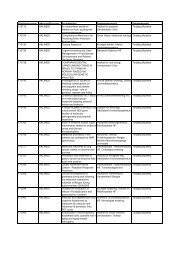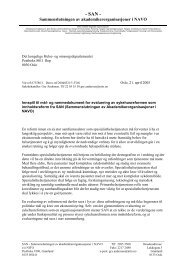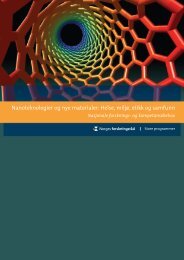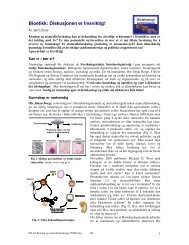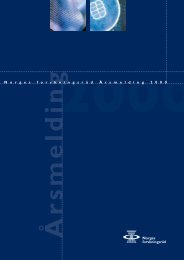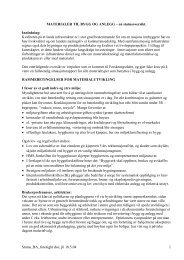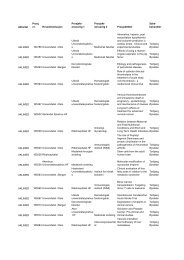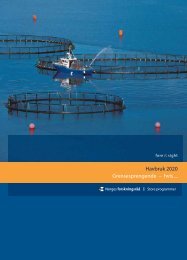A Revolution in R&D
A Revolution in R&D
A Revolution in R&D
Create successful ePaper yourself
Turn your PDF publications into a flip-book with our unique Google optimized e-Paper software.
34<br />
would be excluded from the trial, <strong>in</strong> order to show<br />
high efficacy levels for the subset of patients who<br />
would eventually use the drug. Also excluded would<br />
be patients hav<strong>in</strong>g a specific genetic variation associated<br />
with side effects.<br />
To see the streaml<strong>in</strong><strong>in</strong>g effect of such exclusions,<br />
consider the case of Hercept<strong>in</strong>, a treatment for<br />
advanced breast cancer. It is effective only <strong>in</strong> a subset<br />
of patients—the 25–30 percent whose tumors<br />
overexpress the HER2/neu oncogene. It is this<br />
gene that serves as the drug target. By screen<strong>in</strong>g for<br />
HER2/neu expression, Genentech was able to<br />
exclude nonresponders—some two-thirds of the<br />
subjects orig<strong>in</strong>ally tested—early <strong>in</strong> the cl<strong>in</strong>ical trial.<br />
Without this prescreen<strong>in</strong>g, Genentech would have<br />
needed n<strong>in</strong>e times as many patients <strong>in</strong> phase III to<br />
achieve significant results. The cost of such a trial<br />
would have made Hercept<strong>in</strong> economically unviable.<br />
Turn<strong>in</strong>g to the second benefit, for fail<strong>in</strong>g compounds<br />
pharmacogenetics lowers the hurdle by eas<strong>in</strong>g<br />
the conditions for market viability. Consider<br />
specifically those candidate drugs that reveal serious<br />
side effects <strong>in</strong> a significant proportion of the subjects<br />
(such as the 7 percent of Caucasians with low<br />
levels of CYP2D6, an enzyme that helps metabolize<br />
some 25 percent of all drugs). Traditionally, any<br />
such drug would be perceived as too risky to market,<br />
and would be abandoned <strong>in</strong> precl<strong>in</strong>ical studies.<br />
Today, however, pharmacogenetics makes it possible<br />
to identify the at-risk patients, so the drug would not<br />
be disqualified right away, and could go on to prove<br />
marketable—patients would just need to be tested<br />
for vulnerability before be<strong>in</strong>g given prescriptions.<br />
These are the potential benefits to R&D, the primary<br />
focus of this report. Even greater potential,<br />
some observers believe, may lie <strong>in</strong> market advantages.<br />
Three such advantages are possible: price<br />
premium, share shift, and new patients. In other<br />
words, if a perception emerges that the pharmacogenetics-assisted<br />
drug is dist<strong>in</strong>ctly less risky or dist<strong>in</strong>ctly<br />
more efficacious for the (now restricted) target<br />
patient population, payers may tolerate a higher<br />
price for the drug, physicians may favor it when<br />
offer<strong>in</strong>g new patients a prescription, and patients<br />
who have shunned previous medications (ow<strong>in</strong>g to<br />
side effects, typically) may now choose to try it.<br />
Although it seems reasonable for pharmaceutical<br />
companies to expect some market upside from<br />
more efficacious, better tolerated therapies, it<br />
rema<strong>in</strong>s to be seen to what extent they will be able<br />
to reap these market rewards.<br />
Putt<strong>in</strong>g figures on the cost sav<strong>in</strong>gs pharmacogenetics<br />
benefits might achieve, our model estimates an<br />
average of $335 million <strong>in</strong> the cost to drug—if<br />
pharmacogenetics were to work every time it were<br />
applied. But pharmacogenetics won’t work every<br />
time. Given the set of cases where it is applied and<br />
succeeds, the expected sav<strong>in</strong>gs would average about<br />
$80 million, as discussed below. And of course, correspond<strong>in</strong>g<br />
to the potential market upside, there is<br />
the counterpart scenario—potential destruction of<br />
value <strong>in</strong> the market. Why the uncerta<strong>in</strong>ty? (See<br />
Exhibit 8.)<br />
EXHIBIT 8<br />
PHARMACOGENETICS’ POTENTIAL IS CONTINGENT<br />
Cost to drug<br />
Pre-genomics<br />
Pharmacogenetics:<br />
the promise 1<br />
Pharmacogenetics:<br />
expected sav<strong>in</strong>gs 2<br />
ID Biology<br />
Target ID Target Validation<br />
0<br />
200<br />
Chemistry<br />
400<br />
Screen<strong>in</strong>g Optimization<br />
600<br />
545<br />
800<br />
800<br />
Development<br />
Precl<strong>in</strong>ical Cl<strong>in</strong>ical<br />
SOURCES: Technical literature; <strong>in</strong>dustry <strong>in</strong>terviews; publicly available <strong>in</strong>formation;<br />
BCG analysis.<br />
1Sav<strong>in</strong>gs per drug assum<strong>in</strong>g pharmacogenetics can be applied across the<br />
R&D pipel<strong>in</strong>e.<br />
2 Average sav<strong>in</strong>gs across R&D pipel<strong>in</strong>e, given scientific and market limitations.<br />
880<br />
1,000<br />
$M



